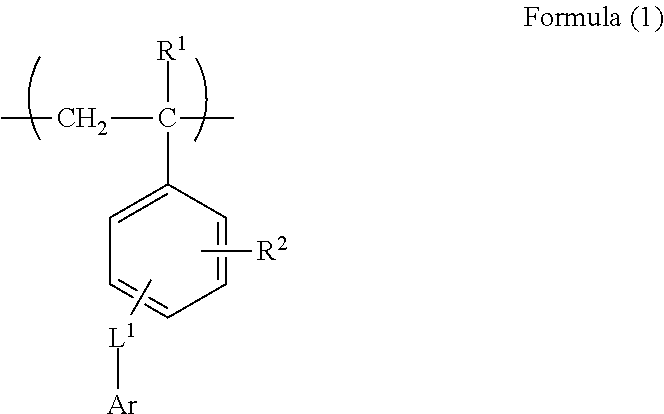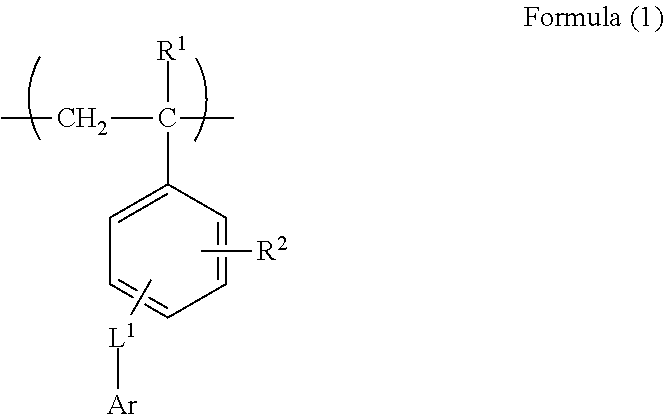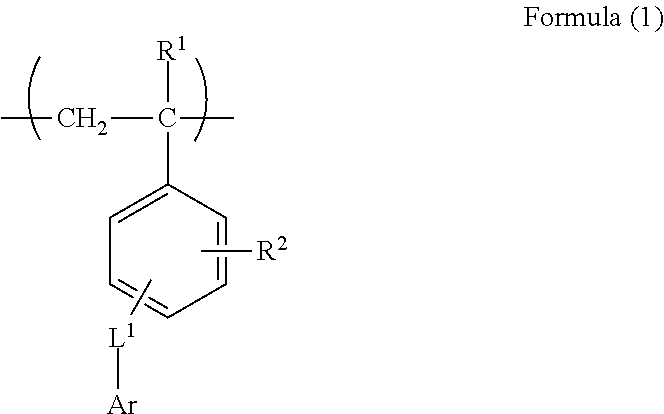Aqueous ink composition and image forming method
a composition and image technology, applied in the field of water ink composition and image forming method, can solve the problems of inability to satisfy the gloss of cured film after photocuring, and it is difficult to say that a printed matter using ink is sufficient,
- Summary
- Abstract
- Description
- Claims
- Application Information
AI Technical Summary
Benefits of technology
Problems solved by technology
Method used
Image
Examples
example 1
Synthesis of Monomer and Polymer
Synthesis Example 1
Synthesis of Monomer
[0193](1) Synthesis of Monomer M-1
[0194]1,800 mL of dimethyl sulfoxide dissolving 375 g of 9(10H)-acridone and 84.8 g of sodium hydroxide were charged in a 5 L three-necked flask equipped with a stirrer and a cooling tube, followed by stirring at room temperature for 10 minutes. Into the flask, 440 g of chloromethyl styrene was added dropwise over 10 minutes, the mixed solution was washed with 300 mL of dimethyl sulfoxide together, followed by heating to 55° C. and a reaction was performed for 7 hours. After completion of the reaction, a mixed solution of 750 mL of methanol and 750 mL of water was added dropwise at 55° C. over 10 minutes, followed by stirring at 40° C. for 30 minutes, and further stirring at 30° C. or less for 1 hour. The obtained slurry was taken out by filtration under reduced pressure, and 3 L of methanol was added to the slurry in the 5 L three-necked flask, followed by stirring at 50° C. for...
synthesis example 2
Synthesis of Polymer B-4
[0202]75 g of the monomer M-1, 50 g of methacrylic acid, 375 g of methyl methacrylate, 120 mg of hydroquinone, and 736 g of methyl ethyl ketone were added in a 300 mL three-necked flask equipped with a stirrer and a cooling tube, followed by heating at 75° C. under nitrogen atmosphere. 9 g of dimethyl-2,2′-azobisisobutyrate dissolved in 40 g of methyl ethyl ketone was added in the three-necked flask, and a reaction was performed for 2 hours, 2.5 g of dimethyl-2,2′-azobisisobutyrate dissolved in 10 g of methyl ethyl ketone was added thereto, and a reaction was further performed for 2 hours. 10 g of dimethyl-2,2′-azobisisobutyrate dissolved in 2.5 g of methyl ethyl ketone was added thereto, followed by raising the temperature to 80° C. The resultant was heated and stirred for 4 hours, and an unreacted monomer was completely reacted. After completion of the reaction, methyl ethyl ketone was added to the obtained polymer solution to prepare 35% by mass of polymer...
synthesis example 3
Synthesis of Other Polymers
[0204]The aforementioned exemplified polymers B-1 to B-3, B-5 to B-20, B-22, B-24, B-35, B-43, B-45, and B-47, B-49, and B-51 were synthesized in the same manner as synthesis of the polymer B-4, except that kind and ratio of each of the monomers was changed and synthesized respectively so as to have structures of respective polymers in the synthesis of the each polymer.
[0205]With respect to these polymers, the weight average molecular weight (Mw) and the acid value were obtained in the same manner as above. Details of the Mw and the acid value are shown in the following Table 1 to 2.
PUM
| Property | Measurement | Unit |
|---|---|---|
| acid value | aaaaa | aaaaa |
| acid value | aaaaa | aaaaa |
| acid value | aaaaa | aaaaa |
Abstract
Description
Claims
Application Information
 Login to View More
Login to View More - R&D
- Intellectual Property
- Life Sciences
- Materials
- Tech Scout
- Unparalleled Data Quality
- Higher Quality Content
- 60% Fewer Hallucinations
Browse by: Latest US Patents, China's latest patents, Technical Efficacy Thesaurus, Application Domain, Technology Topic, Popular Technical Reports.
© 2025 PatSnap. All rights reserved.Legal|Privacy policy|Modern Slavery Act Transparency Statement|Sitemap|About US| Contact US: help@patsnap.com



